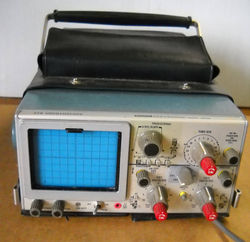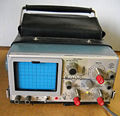326: Difference between revisions
Jump to navigation
Jump to search
No edit summary |
No edit summary |
||
| Line 11: | Line 11: | ||
}} | }} | ||
The '''Sony/Tektronix 326''' is an ultra-portable 10 MHz dual trace oscilloscope | The '''Sony/Tektronix 326''' is an ultra-portable 10 MHz dual trace oscilloscope | ||
with | with a 300 ns delay line and a removable battery pack. | ||
The power supply and oscilloscope are separable. | |||
The scope can be be operated without power supply. | |||
Electrically, it is relatively classic, but it is not constructed like classic Tek scopes. | Electrically, it is relatively classic, but it is not constructed like classic Tek scopes. | ||
| Line 19: | Line 22: | ||
The 326's power supply/charger is conceptually similar to that of the [[323]], | The 326's power supply/charger is conceptually similar to that of the [[323]], | ||
but the 0.3 Ω resistor is in the battery pack. | but the 0.3 Ω resistor is in the battery pack. | ||
{{BeginSpecs}} | {{BeginSpecs}} | ||
| Line 29: | Line 29: | ||
{{Spec | Deflection | 10 mV/Div to 10 V/Div (1 mV/Div to 1 V/Div in ×10 mode) }} | {{Spec | Deflection | 10 mV/Div to 10 V/Div (1 mV/Div to 1 V/Div in ×10 mode) }} | ||
{{Spec | Input impedance | 1 MΩ // 47 pF }} | {{Spec | Input impedance | 1 MΩ // 47 pF }} | ||
{{Spec | Calibrator | 0.5 V<sub>p-p</sub>, 800 Hz | {{Spec | Calibrator | 0.5 V<sub>p-p</sub>, 800 Hz ±250 Hz, source impedance 10 kΩ }} | ||
{{Spec | CRT | 10 × 8 Div. @ 6.25 mm (0.25"), [[154-0667-00|154-0667-xx]] }} | {{Spec | CRT | 10 × 8 Div. @ 6.25 mm (0.25"), [[154-0667-00|154-0667-xx]] }} | ||
{{Spec | AC Power | 90—136 V or 180—272 V, 48—440 Hz, 35 VA at 136 V (maximum intensity, maximum charge rate)}} | {{Spec | AC Power | 90—136 V or 180—272 V, 48—440 Hz, 35 VA at 136 V (maximum intensity, maximum charge rate)}} | ||
| Line 37: | Line 37: | ||
{{Spec | Weight | 5.9 kg (4.5 kg without charger) }} | {{Spec | Weight | 5.9 kg (4.5 kg without charger) }} | ||
{{Spec | Features | | {{Spec | Features | | ||
* Ext Trig / X input (supports X-Y displays up to | * Ext Trig / X input (supports X-Y displays up to 200 kHz) | ||
* External blanking input (by deflection, not Z modulation, to | * External blanking input (by deflection, not Z modulation, to 100 kHz) | ||
* Built-in battery | * Built-in battery | ||
}} | }} | ||
{{EndSpecs}} | {{EndSpecs}} | ||
==Pictures== | ==Pictures== | ||
<gallery> | <gallery> | ||
Sony_tek_326.jpg|front | |||
Tek 326 rear.jpg|rear | |||
326_1.jpg|open, lower | |||
326_2.jpg|open, upper | |||
326_accu.jpg|new battery pack (homemade from 9 pieces NiCd sub-C cell) | |||
Tek 326 trace1.jpg | Tek 326 trace1.jpg | ||
Tek 326 trace2.jpg | Tek 326 trace2.jpg | ||
Revision as of 11:58, 3 June 2018
The Sony/Tektronix 326 is an ultra-portable 10 MHz dual trace oscilloscope with a 300 ns delay line and a removable battery pack.
The power supply and oscilloscope are separable. The scope can be be operated without power supply.
Electrically, it is relatively classic, but it is not constructed like classic Tek scopes.
The 326 has no Tek-made ICs. It uses many Sony transistors.
The 326's power supply/charger is conceptually similar to that of the 323, but the 0.3 Ω resistor is in the battery pack.
Key Specifications
| Bandwidth | 10 MHz (approx. 5 MHz in ×10 mode) |
|---|---|
| Rise time | 36 ns (72 ns in ×10 mode) |
| Sweep | 1 μs/Div to 1 s/Div, 1—2—5, ×10 magnifier (i.e. to 100 ns/Div) |
| Deflection | 10 mV/Div to 10 V/Div (1 mV/Div to 1 V/Div in ×10 mode) |
| Input impedance | 1 MΩ // 47 pF |
| Calibrator | 0.5 Vp-p, 800 Hz ±250 Hz, source impedance 10 kΩ |
| CRT | 10 × 8 Div. @ 6.25 mm (0.25"), 154-0667-xx |
| AC Power | 90—136 V or 180—272 V, 48—440 Hz, 35 VA at 136 V (maximum intensity, maximum charge rate) |
| DC Power | 9—32 V, 12 W max. |
| Battery | Nine size "C" NiCd cells, runtime 1.5 h (full intensity) / 4 h (low intensity), charge time 16 h |
| Dimensions | 10.2 cm × 22.2 cm × 38.1 cm (31 cm without charger) |
| Weight | 5.9 kg (4.5 kg without charger) |
| Features |
|
Pictures
-
front
-
rear
-
open, lower
-
open, upper
-
new battery pack (homemade from 9 pieces NiCd sub-C cell)
-
-
-
-









